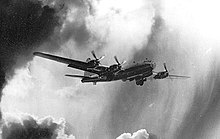1952 Habomai Islands RB-29 shootdown incident
The 1952 Habomai Islands RB-29 shootdown incident occurred on October 7, 1952, when a United States Air Force (USAF) RB-29 reconnaissance aircraft was shot down by Soviet forces while conducting intelligence-gathering operations near the Habomai Islands, close to the eastern coast of Hokkaido, Japan. All eight crew members aboard the aircraft were killed in the incident.[1][2][3] This incident marked a significant moment of Cold War tensions between the United States and the Soviet Union. Notably, a similar RB-29 shootdown occurred in the same region in 1954.[1]
Overview
In 1952, the world was deep into the Cold War, a period marked by political and military tension between the Western Bloc, led by the United States, and the Eastern Bloc, led by the Soviet Union. The Korean War was actively raging on the Korean Peninsula, and tensions in Northeast Asia were high due to the geopolitical rivalry. Japan, which had recently emerged from post-World War II occupation, did not yet have its own air force. Instead, American military forces, particularly the US Air Force, were stationed across Japan to protect American interests and to conduct surveillance and intelligence missions against communist threats in the region.[4]
The 91st Strategic Reconnaissance Squadron, part of the USAF's 15th Air Force, was based at Yokota Air Base in Japan. This squadron was actively involved in intelligence-gathering missions over Northeast Asia, monitoring Soviet military activities and gathering electronic and photographic intelligence.
On October 7, 1952, an RB-29 Superfortress, codenamed "Sunbonnet King," from the 91st Strategic Reconnaissance Squadron was on a reconnaissance mission over the North Pacific Ocean, east of Hokkaido. As the aircraft flew near Nemuro, a city on Hokkaido's eastern coast, and the disputed Habomai Islands, it encountered an unidentified aircraft. Despite receiving warnings from radar stations about the unidentified aircraft approaching, the crew of the RB-29 decided to continue their mission, prioritizing intelligence collection over immediate safety concerns.[1][5]
Shortly afterward, the RB-29 sent out an emergency distress signal, and communication was lost. The aircraft, along with its eight crew members, went missing. In response, the US military dispatched F-84 Thunderjet fighter jets and rescue aircraft from Misawa Air Base in northern Japan to search for the missing RB-29. Despite extensive search efforts, the aircraft was never found.[1]
Based on the available evidence and the context of Cold War espionage activities, it is widely believed that the RB-29 was intercepted and shot down by Soviet fighter jets. The Soviet Union, which had established a robust air defense network in the region to protect its Far Eastern territories and military installations, was highly vigilant against any perceived intrusions or reconnaissance activities by the United States and its allies.[1] The shootdown of the RB-29 highlighted the extreme risks involved in Cold War reconnaissance missions and underscored the dangerous brinkmanship between the two superpowers.
Aftermath
The incident contributed to escalating Cold War tensions and underscored the fraught nature of aerial reconnaissance missions during this period. The loss of the RB-29 and its crew was a stark reminder of the high stakes involved in intelligence operations. For the United States, it was a call to improve both the security protocols for reconnaissance missions and the technological capabilities of its surveillance aircraft. Meanwhile, the Soviet Union remained resolute in its efforts to protect its airspace from any foreign intrusion.[6]
This event also became a part of the broader narrative of Cold War confrontations that occasionally flared into direct conflict, even if the battles were often fought in the shadows through intelligence and counterintelligence efforts. The RB-29 incident is one of several Cold War aviation incidents where reconnaissance missions resulted in aircraft losses and crew casualties, reflecting the tense and perilous nature of East–West relations during the era.[6]
References
- ^ a b c d e "Maybe You Had to Be There" (PDF). NSA. 2012-05-10. Retrieved 2021-04-29.
- ^ "H-029-3: A Brief History of U.S. Navy Cold War Aviation Incidents (Excluding Korea and Vietnam)". Naval History and Heritage Command. Retrieved 2021-04-29.
- ^ "Service Member S SGT SAMUEL ALBION COLGAN". Department of Defense POW/MIA Accounting Agency. Retrieved 2021-04-29.
- ^ Nishiyama, Kunio (2020). Strategic Aerial Reconnaissance: The Unknown Peace-Time Battles. Namiki Shobo. pp. 36–67. ISBN 978-4-89063-404-0.
- ^ "Fred Grady Kendrick". American Battle Monuments Commission. Retrieved 2021-04-29.
- ^ a b "Rising Tensions Recall RB-29 Superfortress Shot Down Over Northern Territories 70 Years Ago". Japan-Forward. 6 October 2022. Retrieved 2024-09-04.

